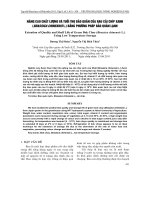Báo cáo về Trí tuệ thông minh nhân tạo (Artificial intelligence) tiếng Anh
Bạn đang xem bản rút gọn của tài liệu. Xem và tải ngay bản đầy đủ của tài liệu tại đây (91.82 KB, 12 trang )
Technical Writing And Presentation
Table of Contents
POINT OF VIEW
“Some people call this artificial intelligence, but the reality is this technology will
enhance us. So instead of artificial intelligence, I think we’ll augment our intelligence.”
- Binh “One day the word "Soon" will be replaced by "Finally".”
- Hoa “Software is eating the world, but AI is going to eat software.”
- Nam “AI is neither good nor evil. It’s a tool. It’s a technology for us to use.”
- Dung -
1
Technical Writing And Presentation
Artificial Intelligence
1. Introduction
1.1. Definition
AI (Artificial Intelligence) is a machine’s ability to perform cognitive functions as humans do,
such as perceiving, learning, reasoning, and solving problems. The benchmark for AI is the
human level concerning in teams of reasoning, speech, and vision.
1.2. History
AI was a term first coined at Dartmouth College in 1956. Cognitive scientist Marvin Minsky
was optimistic about the technology's future. The 1974-1980 saw government funding in the
field drop, a period known as "AI winter", when several criticised progress in the field.
However, the fervour was revived afterwards in the 1980s when the British government
started funding the technology again, especially because they were worried about competition
with the Japanese. In 1997, IBM's Deep Blue began the first computer to beat a Russian
Grandmaster, making history.
2. Types of AI
Using these characteristics for reference, all artificial intelligence systems - real and
hypothetical - fall into one of three types:
• Artificial narrow intelligence (ANI), which has a narrow range of abilities
• Artificial general intelligence (AGI), which is on par with human capabilities
• Artificial superintelligence (ASI), which is more capable than a human
2.1. Artificial Narrow Intelligence (ANI) / Weak AI / Narrow AI
Artificial narrow intelligence (ANI), also referred to as weak AI or narrow AI, is the only type
of artificial intelligence we have successfully realized to date. Narrow AI is goal-oriented,
designed to perform singular tasks and is very intelligent at completing the specific task it is
programmed to do.
While these machines may seem intelligent, they operate under a narrow set of constraints
and limitations, which is why this type is commonly referred to as weak AI. Narrow AI doesn’t
mimic or replicate human intelligence, it merely simulates human behaviour based on a narrow
range of parameters and contexts.
Narrow AI has experienced numerous breakthroughs in the last decade, powered by
achievements in machine learning and deep learning.
2
Technical Writing And Presentation
Narrow AI’s machine intelligence comes from the use of natural language processing (NLP)
to perform tasks. NLP is evident in chatbots and similar AI technologies. By understanding
speech and text in natural language, AI is programmed to interact with humans in a natural,
personalised manner.
Narrow AI can either be reactive, or have a limited memory. Reactive AI is incredibly basic; it
has no memory or data storage capabilities, emulating the human mind’s ability to respond to
different kinds of stimuli without prior experience. Limited memory AI is more advanced,
equipped with data storage and learning capabilities that enable machines to use historical data to
inform decisions.
Examples of narrow AI:
• Siri by Apple, Alexa by Amazon, Cortana by Microsoft and other virtual assistants
• Image / facial recognition software
• Entertainment or marketing content recommendations based on watch/listen/purchase
behaviour
• Self-driving cars
2.2. Artificial General Intelligence (AGI) / Strong AI / Deep AI
Artificial general intelligence (AGI), also referred to as strong AI or deep AI, is the concept of
a machine with general intelligence that mimics human intelligence and/or behaviours, with the
ability to learn and apply its intelligence to solve any problem. AGI can think, understand, and
act in a way that is indistinguishable from that of a human in any given situation.
AI researchers and scientists have not yet achieved strong AI. To succeed, they would need to
find a way to make machines conscious, programming a full set of cognitive abilities. Machines
would have to take experiential learning to the next level, not just improving efficiency on
singular tasks, but gaining the ability to apply experiential knowledge to a wider range of
different problems.
Strong AI uses a theory of mind AI framework, which refers to the ability to discern needs,
emotions, beliefs and thought processes of other intelligent entitles. Theory of mind level AI is
not about replication or simulation, it’s about training machines to truly understand humans.
Fujitsu-built K, one of the fastest supercomputers, is one of the most notable attempts at
achieving strong AI, but considering it took 40 minutes to simulate a single second of neural
activity, it is difficult to determine whether or not strong AI will be achieved in our foreseeable
future.
2.3. Artificial Superintelligence (ASI)
Artificial super intelligence (ASI), is the hypothetical AI that doesn’t just mimic or understand
human intelligence and behaviour, ASI is where machines become self-aware and surpass the
capacity of human intelligence and ability.
3
Technical Writing And Presentation
In addition to replicating the multi-faceted intelligence of human beings, ASI would
theoretically be exceedingly better at everything we do; math, science, emotional relationships,
… ASI would have a greater memory and a faster ability to process and analyse data and stimuli.
Consequently, the decision-making and problem solving capabilities of super intelligent beings
would be far superior than those of human beings.
The potential of having such powerful machines at our disposal may seem appealing, but the
concept itself has a multitude of unknown consequences. If self-aware super intelligent beings
came to be, they would be capable of ideas like self-preservation. The impact this will have on
humanity, our survival, and our way of life, is pure speculation.
3. Subfields of Artificial Intelligence
Major sub-fields of AI now include: Machine Learning, Neural Networks, Evolutionary
Computation, Vision, Robotics, Expert Systems, Speech Processing, Natural Language
Processing, and Planning. But in this chapter we will discuss about 2 basic sub-fields of AI: Deep
Learning and Machine Learning.
3.1. Deep Learning
- Definition
Deep learning is a computer software that mimics the network of neurons in a brain. It is a
subset of machine learning and is called deep learning because it makes use of deep neural
networks. In deep learning, the learning phase is done through a neural network. A neural
network is an architecture where the layers are stacked on top of each other.
-
How does Deep Learning work?
Deep learning networks learn by discovering intricate structures in the data they experience.
By building computational models that are composed of multiple processing layers, the networks
can create multiple levels of abstraction to represent the data.
- Types of Deep Neural Networks
• Convolutional Neural Network (CNN) - CNN is a class of deep neural networks most
•
•
•
commonly used for image analysis.
Recurrent Neural Network (RNN) - RNN uses sequential information to build a model. It
often works better for models that have to memorize past data.
Generative Adversarial Network (GAN) - GAN are algorithmic architectures that use two
neural networks to create new, synthetic instances of data that pass for real data.
Deep Belief Network (DBN) - DBN is a generative graphical model that is composed of
multiple layers of latent variables called hidden units. Each layer is interconnected, but
the units are not.
3.2. Machine Learning
- Definition
Machine Learning is a type of AI in which a computer is trained to automate tasks that are
exhaustive or impossible for human beings. It is the best tool to analyze, understand, and identify
4
Technical Writing And Presentation
patterns in data based on the study of computer algorithms. Machine learning can make decisions
with minimal human intervention.
-
How does Machine Learning work?
Machine learning accesses vast amounts of data (both structured and unstructured) and learns
from it to predict the future. It learns from the data by using multiple algorithms and techniques.
Below is a diagram that shows how a machine learns from data.
- Types of Machine Learning
• Supervised Learning
In supervised learning, the data is already labeled, which means you know the target variable.
Using this method of learning, systems can predict future outcomes based on past data.
•
Unsupervised Learning
Unsupervised learning algorithms employ unlabeled data to discover patterns from the data
on their own. The systems are able to identify hidden features from the input data provided. Once
the data is more readable, the patterns and similarities become more evident.
•
Reinforcement Learning
The goal of reinforcement learning is to train an agent to complete a task within an uncertain
environment. The agent receives observations and a reward from the environment and sends
actions to the environment. The reward measures how successful action is with respect to
completing the task goal.
-
Machine Learning Processes
Machine Learning involves seven steps: Data gathering, Data Pre-Processing, Choose Model,
Train Model, Test Model, Tune Model, Prediction
- Machine Learning Applications
• Sales forecasting for different products
• Fraud analysis in banking
• Product recommendations
• Stock price prediction
3.3. Difference between Machine Learning and Deep Learning
Parameter
Machine Learning
Deep Learning
Data
Excellent performances
Excellent performance on a big dataset
Dependencies
on a small/medium
dataset
Hardware
Work on a low-end
Requires powerful machine, preferably
dependencies
machine.
with GPU: DL performs a significant
amount of matrix multiplication
5
Technical Writing And Presentation
4. Application of AI
4.1. AI Application in E-Commerce
- Personalized Shopping
Artificial Intelligence technology is used to create recommendation engines through which
you can engage better with your customers. These recommendations are made in accordance
with their browsing history, preference, and interests. It helps in improving your relationship
with your customers and their loyalty towards your brand.
-
AI-powered Assistants
Virtual shopping assistants and chatbots help improve the user experience while shopping
online. Natural Language Processing is used to make the conversation sound as human and
personal as possible. Moreover, these assistants can have real-time engagement with your
customers.
-
Fraud Prevention
Credit card frauds and fake reviews are two of the most significant issues that E-Commerce
companies deal with. By considering the usage patterns, AI can help reduce the possibility of
credit card frauds taking place. Many customers prefer to buy a product or service based on
customer reviews. AI can help identify and handle fake reviews.
4.2. Applications Of Artificial Intelligence in Education
- Administrative Tasks Automated to Aid Educators
Artificial Intelligence can help educators with non-educational tasks like facilitating and
automating personalized messages to students, arranging and facilitating parent and guardian
interactions, HR-related topics,…
-
Creating Smart Content
Artificial Intelligence helps create a rich learning experience by generating and providing
audio and video summaries and integral lesson plans.
-
Voice Assistants
Without even the direct involvement of the lecturer or the teacher, a student can access extra
learning material or assistance through Voice Assistants.
-
Personalized Learning
Using AI technology, hyper-personalization techniques can be used to monitor students’ data
thoroughly, and habits, lesson plans, reminders, study guides, flash notes, frequency or revision,
etc., can be easily generated.
4.3. Applications of Artificial Intelligence in Lifestyle
- Autonomous Vehicles
6
Technical Writing And Presentation
Automobile manufacturing companies like Toyota, Audi, Volvo, and Tesla use machine
learning to train computers to think and evolve like humans when it comes to driving in any
environment and object detection to avoid accidents.
-
Spam Filters
The email that we use in our day-to-day lives has AI that filters out spam emails sending them
to spam or trash folders, letting us see the filtered content only. The popular email provider,
Gmail, has managed to reach a filtration capacity of approximately 99.9%.
-
Facial Recognition
Our favorite devices like our phones, laptops, and PCs use facial recognition techniques by
using face filters to detect and identify in order to provide secure access. Apart from personal
usage, facial recognition is a widely used Artificial Intelligence application even in high securityrelated areas in several industries.
-
Recommendation System
Various platforms that we use in our daily lives like e-commerce, entertainment websites,
social media, video sharing platforms, like youtube, etc., all use the recommendation system to
get user data and provide customized recommendations to users to increase engagement. This is
a very widely used Artificial Intelligence application in almost all industries.
4.4. Applications of Artificial Intelligence in Robotics
Robotics is another field where artificial intelligence applications are commonly used. Robots
powered by AI use real-time updates to sense obstacles in its path and pre-plan its journey
instantly.
It can be used for:
• Carrying goods in hospitals, factories, and warehouses
• Cleaning offices and large equipment
• Inventory management
4.5. Applications of Artificial Intelligence in Social Media
On Instagram, AI considers your likes and the accounts you follow to determine what posts
you are shown on your explore tab.
-
Artificial Intelligence is also used along with a tool called DeepText. With this tool, Facebook
can understand conversations better. It can be used to translate posts from different languages
automatically.
-
7
Technical Writing And Presentation
AI is used by Twitter for fraud detection, removing propaganda, and hateful content. Twitter
also uses AI to recommend tweets that users might enjoy, based on what type of tweets they
engage with.
4.6. Applications of Artificial Intelligence in Marketing
Artificial intelligence (AI) applications are popular in the marketing domain as well.
• Using AI, marketers can deliver highly targeted and personalized ads with the help of
behavioral analysis, pattern recognition, etc. It also helps with retargeting audiences at the right
time to ensure better results and reduced feelings of distrust and annoyance.
• AI can help with content marketing in a way that matches the brand's style and voice. It
can be used to handle routine tasks like performance, campaign reports, and much more.
• Chatbots powered by AI, Natural Language Processing, Natural Language Generation,
and Natural Language Understanding can analyze the user's language and respond in the ways
humans do.
• AI can provide users with real-time personalizations based on their behavior and can be
used to edit and optimize marketing campaigns to fit a local market's needs.
5. The Evolution of AI
1950’s: Starting Period
-
In 1956, John McCarthy first used the term Artificial Intelligence. Demonstration of the
first running AI program at Carnegie Mellon University.
In the same year, Los Alamos chess is the first program to play a chess-like game,
developed by Paul Stein and Mark Wells.
1960’s: Rising Period
-
In 1964, Danny Bobrow’s dissertation at MIT showed how computers could understand
natural language.
In 1965, ELIZA, an interactive computer program that could functionally converse in
English with a person, was created at the MIT Artificial Intelligence Laboratory by
Joseph Weizenbaum.
1970’s to 1980’s: Low Development Period
-
In 1972, WABOT-1, the first anthropomorphic robot was built in Japan at Waseda
University.
In 1980, WABOT-2, which can converse with a person, read a normal musical score with
is eye and play tunes of average difficulty on an electronic organ, was built and became
the first milestone in developing a "personal robot".
1980’s to 1990’s: Steady Development Period
-
In 1995, computer scientist Richard Wallace developed the software chatbot ALICE
inspired by Eliza.
8
Technical Writing And Presentation
-
In 1997, The Deep Blue Chess Program beat the then world chess champion, Garry
Kasparov.
21st Century: Blooming Period
-
-
-
In 2000, interactive robot pets have become commercially available. MIT displays
Kismet, a robot with a face that expresses emotions.
In 2009, Google secretly developed a driverless car and by 2014 it passed Nevada selfdriving test.
In 2010, Microsoft launched Kinect for Xbox 360 the first gaming device that tracks
human body.
In 2011, Apple released Siri, a virtual assistant on Apple iOS operating systems.
In 2012, Google researchers trained a large neural network of sixteen thousand processors
to recognize images of cats by showing it 10 million unlabeled images from YouTube
videos.
In 2014, Microsoft released Cortana their version of a virtual assistant, also Amazon
created Amazon Alexa, a home assistant that developed into smart speakers that function
as personal assistants.
In 2016 a humanoid robot named Sophia was created by Hanson Robotics. She's the first
robot citizen with her ability to see make facial expressions and communicate through AI.
In 2018, Google developed BERT - the first deeply bidirectional, unsupervised language
representation, pre-trained using only a plain text corpus.
6. Future of AI
Artificial intelligence is shaping the future of humanity across nearly every industry. It is
already the main driver of emerging technologies like big data, robotics and IoT, and it will
continue to act as a technological innovator for the foreseeable future.
So let’s see how artificial intelligence is poised to fundamentally restructure broader swaths of
our economy and society over the next decade with 4 bold predictions that are informed by
experts and scientists in the field.
6.1. AI and Machine Learning will transform the scientific method
AI enables an unprecedented ability to analyze enormous data sets and computationally
discover complex relationships and patterns. AI, augmenting human intelligence, is primed to
transform the scientific research process, unleashing a new golden age of scientific discovery in
the coming years.
6.2. AI will enable next-gen consumer experiences
Next-generation consumer experiences like the metaverse and cryptocurrencies have garnered
much buzz. These experiences and others like them will be critically enabled by AI.
AI algorithms have the potential to learn much more quickly in a digital world (e.g., virtual
driving to train autonomous vehicles). These are natural catalysts for AI to bridge the feedback
loops between the digital and physical realms. For instance, blockchain, cryptocurrency and
distributed finance, at their core, are all about integrating frictionless capitalism into the
economy.
9
Technical Writing And Presentation
6.3. Addressing the climate crisis will require AI
As a society we have much to do in mitigating the socioeconomic threats posed by climate
change. Carbon pricing policies, still in their infancy, are of questionable effectiveness.
One potential new approach involves prediction markets powered by AI that can tie policy to
impact, taking a holistic view of environmental information and interdependence. This would
likely be powered by digital "twin Earth" simulations that would require staggering amounts of
real-time data and computation to detect nuanced trends imperceptible to human senses. Other
new technologies such as carbon dioxide sequestration cannot succeed without AI-powered risk
modeling, downstream effect prediction and the ability to anticipate unintended consequences.
6.4. AI will enable truly personalized medicine
Simply put, AI is uniquely suited to construct and analyze "digital twin" rubrics of individual
biology and is able to do so in the context of the communities an individual lives in. The human
body is mind-boggling in its complexity, and it is shocking how little we know about how drugs
work (paywall). Without AI, it is impossible to make sense of the massive datasets from an
individual’s physiology, let alone the effects on individual health outcomes from environment,
lifestyle and diet. AI solutions have the potential not only to improve the state of the art in
healthcare, but also to play a major role in reducing persistent health inequities.
7. Pros and Cons
7.1. Pros
- Diminishes Human Error
Since AI decisions come from compiled data with the aid of designed algorithms, errors are
reduced, accuracy is increased, and precision is possible. Ultimately, fewer mistakes equal
savings in both time and resources, so AI becomes a win-win for your company.
-
Facilitates Faster Decision-Making
Finding ways to save time by making faster decisions you feel confident in is always
valuable. AI can do this for you. The more decisions AI makes, the more it has to pull from for
future decision-making, improving the process.
-
Offers Continual 24/7 Availability
AI never rests or requires sleep, while the human body and mind need rest to continue to
function at optimal levels. This continual availability 24 hours a day, 7 days a week with no gap
in coverage, can make a huge impact on increases in your company’s productivity.
-
Provides Digital Assistants
Digital assistants can significantly reduce the need for excessive customer service staff. For
example, the rise in the use of chatbots already proves how useful they can be in directing
customers to the information needed. Another is the rising voice bot to help with queries.
-
Excels at Working with Large Sets of Data
10
Technical Writing And Presentation
The more data available, the more AI is needed to make sense of it all in less time. Artificial
intelligence is highly beneficial in making sense of the large sets of data available these days. It
can both acquire and extract data rapidly, but that’s not all. From there, AI takes the data further
with interpretation and transformation.
7.2. Cons
- Requires Higher Overall Costs
It’s no secret AI is expensive. The initial set-up alone requires a high investment.
-
Reduces Employment
While replacing repetitive jobs and other types of work with AI is beneficial to a company, it
will undoubtedly also affect employment. Traditional job roles will be phased away, leading to
unemployment of those who do them.
-
Lacks Creative Ability
One of the drawbacks of using AI, particularly when playing a role in your content marketing
strategy, is its inability to be creative and innovative.
-
Absence of Emotional Range
While AI-enhanced machines can work faster and continually, they cannot factor emotion into
decisions.
-
Increases Potential for Human Laziness
Automating tasks and utilizing more and more digital assistants can lead to increased machine
dependency and even human laziness. Relying on AI can cause us to use our brains less to
memorize, strategize, and solve issues on our own. The effects this may have on future
generations may be vast if left unacknowledged.
8. Conclusion
-
-
Through AI, computers have the ability to harness massive amounts of data and use their
learned intelligence to make optimal decisions and discoveries in fractions of the time
that it would take humans.
AI is already the main driver of emerging technologies and it will continue to act as a
technological innovator for the foreseeable future.
AI has good and bad impact but one thing is certain: AI will be available to every
category human in the future
11









